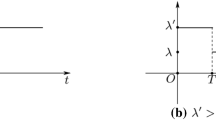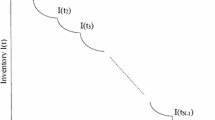Abstract
We investigate the structural properties of a finite horizon, discrete time single product inventory rationing problem, where we allow random replenishment (production) opportunities. In contrast to the standard models of dynamic capacity control in revenue management or production/inventory systems, we assume that the demand/production rates are not known with certainty but lie in some interval. To address this uncertainty, we formulate a robust stochastic dynamic program and show how the structural properties of the optimal policy propagate to the robust counterpart of the problem. Further, we explore how the optimal policy changes with respect to the uncertainty set. We also show that our results can be extended to certain alternative robust formulations.







Similar content being viewed by others
References
Aydin, S., Akcay, Y., & Karaesmen, F. (2009). On the structural properties of a discrete-time single product revenue management problem. Operations Research Letters, 37(4), 273–279.
Ball, M. O., & Queyranne, M. (2009). Toward robust revenue management: Competitive analysis of online booking. Operations Research, 57(4), 950–963.
Ben-Tal, A., El Ghaoui, L., & Nemirovskiĭ, (2009). Robust optimization. Princeton, NJ: Princeton Univ Press.
Bertsimas, D., & Paschalidis, I. (2001). Probabilistic service level guarantees in make-to-stock manufacturing systems. Operations Research, 49(1), 119–133.
Bertsimas, D., & Thiele, A. (2006). A robust optimization approach to inventory theory. Operations Research, 54(1), 150–168.
Birbil, S. I., Frenk, J. B. G., Gromicho, J. A. S., & Zhang, S. (2009). The role of robust optimization in single-leg airline revenue management. Management Science, 55(1), 148.
Cil, E. B., Ormeci, E. L., & Karaesmen, F. (2009). Effects of system parameters on the optimal policy structure in a class of queueing control problems. Queueing Systems, 61(4), 273–304.
De Vericourt, F., Karaesmen, F., & Dallery, Y. (2000). Dynamic scheduling in a make-to-stock system: A partial characterization of optimal policies. Operations Research, 48(5), 811–819.
De Vericourt, F., Karaesmen, F., & Dallery, Y. (2002). Optimal stock allocation for a capacitated supply system. Management Science, 48, 1486–1501.
Gayon, J. P., de Véricourt, F., & Karaesmen, F. (2009). Stock rationing in an \(M/E_r/1\) multi-class make-to-stock queue with backorders. IIE Transactions, 41(12), 1096–1109.
Ha, A. Y. (1997). Inventory rationing in a make-to-stock production system with several demand classes and lost sales. Management Science, 43(8), 1093–1103.
Ha, A. Y. (2000). Stock rationing in an \(M/E_k/1\) make-to-stock queue. Management Science, 46(1), 77–87.
Ha, A. Y. (1997). Inventory rationing in a make-to-stock production system with several demand classes and lost sales. Management Science, 43, 1093–1103.
Ha, A. Y. (1997). Stock-rationing policy for a make-to-stock production system with two priority classes and backordering. Naval Research Logistics (NRL), 44(5), 457–472.
Huang, B., & Iravani, S. M. R. (2008). A make-to-stock system with multiple customer classes and batch ordering. Operations Research, 56(5), 1312–1320.
Iyengar, G. N. (2005). Robust dynamic programming. Mathematics of Operations Research, 30(2), 257.
Jain, A., Lim, A. E. B., & Shanthikumar, J. G. (2010). On the optimality of threshold control in queues with model uncertainty. Queueing Systems, 65(2), 157–174.
Koole, G. (1998). Structural results for the control of queueing systems using event-based dynamic programming. Queueing Systems, 30(3), 323–339.
Koole, G. (2006). Monotonicity in Markov reward and decision chains: Theory and applications. Boston: Now Publishers Inc.
Lan, Y., Gao, H., Ball, M., & Karaesmen, I. (2008). Revenue management with limited demand information. Management Science, 54(9), 1594–1609.
Lautenbacher, C. J., & Stidham, S, Jr. (1999). The underlying Markov decision process in the single-leg airline yield-management problem. Transportation Science, 33(2), 136.
Lim, A. E. B., & Shanthikumar, J. G. (2007). Relative entropy, exponential utility, and robust dynamic pricing. Operations Research, 55(2), 198–214.
Nilim, A., & Ghaoui, L. E. (2005). Robust control of Markov decision processes with uncertain transition matrices. Operations Research, 53(5), 780–798.
Paschalidis, I. C. & Kang, S. C. (2008). A robust approach to Markov decision problems with uncertain transition probabilities. In Proceedings of the 17th IFAC World Congress, (pp. 408–413).
Satia, J. K., & Lave, R. E, Jr. (1973). Markovian decision processes with uncertain transition probabilities. Operations Research, 21(3), 728–740.
Talluri, K. T., & Van Ryzin, G. (2005). The theory and practice of revenue management (Vol. 68). New York: Springer Verlag.
Turgay, Z., Karaesmen, F., & Ormeci, L. (2013). Structural properties of a class of robust inventory and queueing control problems. Technical report. Istanbul: Koc University.
Xu, H., & Mannor, S. (2012). Distributionally robust markov decision processes. Mathematics of Operations Research, 37, 288–300.
Author information
Authors and Affiliations
Corresponding author
Appendices
Appendix 1: A proof of theorem
Before proving Theorem 1 we introduce a simple algorithm that starts with \(\varvec{\lambda }\) and ends up with \(\varvec{\lambda }'\) (where \(\varvec{\lambda }_{t} \succeq \varvec{\lambda }'_{t}\)) by a sequence of reallocation of probabilities. By definition, \(\sum _{i=1}^{n+1} \lambda _{i} \;\le \;1\) and \(\sum _{i=1}^{n+1} \lambda '_{i}\;\le \;1\). Now consider the following sequence of vectors, \(\varvec{\lambda }^{(1)}, \varvec{\lambda }^{(2)},...,\varvec{\lambda }^{(n+1)}\). Let \(\varvec{\lambda }^{(1)}= \varvec{\lambda }\).
Now let \(\epsilon _1=\lambda _{1}-\lambda '_{1}\), we construct \(\varvec{\lambda }^{(2)}=\varvec{\lambda }^{(1)}+(-\epsilon _1,\epsilon _1,0,0,...,0)\). Obviously \(\epsilon _1\ge 0\). In the next iteration, we let \(\epsilon _2=\lambda _{2}+\lambda _{1}\) \(-\lambda '_{1}-\lambda '_{2}\), again \(\epsilon _2\ge 0\) and \(\varvec{\lambda }^{(3)}=\varvec{\lambda }^{(2)}+(0,-\epsilon _2,\epsilon _2,0,...,0)\). We continue to iterate similarly for \(n\) steps. At step \(n\) we have: \(\varvec{\lambda }^{(n)}=\varvec{\lambda }^{(n-1)}+(0,0,...,-\epsilon _{n},\epsilon _{n})\). At step \(n\) we have: \(\varvec{\lambda }^{(n+1)}=\varvec{\lambda }^{(n-1)}+(0,0,...,-\epsilon _{n+1})\). By construction, we have \(\varvec{\lambda }^{(n+1)}=\varvec{\lambda }'\). In addition, the sequence of vectors have the property \(\varvec{\lambda }^{(1)} \preceq \varvec{\lambda }^{(2)} \preceq ... \preceq \varvec{\lambda }^{(n+1)}\).
Proof
We prove the desired result in two phases corresponding to stages \(t\) and \(t+1\). Consider two systems that are identical and substitute \(\varvec{\lambda }_{t}\) with \(\varvec{\lambda }'_{t}\) and \(\mu _t\) with \(\mu '_t\). In the first phase, we prove that \( \Delta v_t(x) \ge \Delta v'_t(x)\) holds at \(t\), then in the second phase we prove that \(\Delta v_{t+1}(x) \ge \Delta v'_{t+1}(x)\). Please note that at stage \(t\), we have \(v_{t-1}(x)=v'_{t-1}(x)\), for all \(x\) and \(\varvec{\lambda }_{t} \ne \varvec{\lambda }'_{t}\) and \(\mu _{t+1}\ne \mu '_{t+1}\) whereas in stage \(t+1\), \(\varvec{\lambda }_{t+1} = \varvec{\lambda }'_{t+1}\) and \(\mu _{t+1}=\mu '_{t+1}\).
Suppose \(\Delta v_t(x) \ge \Delta v'_t(x)\) holds, then \(v_t(x)- v'_t(x) \ge v_t(x-1)- v'_t(x-1)\). This implies that as we replace the \(\varvec{\lambda }_{t}\) with \(\varvec{\lambda }'_{t}\) at stage \(t\) the loss in \(v_t(x)\) is greater than loss in \(v_t(x-1)\). Whereas as we replace \(\mu _t\) with \(\mu '_t\) at stage \(t\), associated gain in \(v_t(x)\) is less than gain in \(v_t(x-1)\). We again use the above algorithm in order to perform such a replacement. Hence, we consecutively decrease the arrival probability of a class \(i\) by \(\epsilon \) and increase a class \(j\) by \(\epsilon \) where \(i< j\). Then we simply increase the production rate by \(\mu '_t-\mu _t\).
We prove the inequality case by case, note that \(A\) stands for admission and \(R\) stands for rejection. The non-trivial cases are listed below (we do not present the cases where all classes are accepted or all classes are rejected since these are obvious). Please note that accepting a lower class (\(j\)) means that a higher class (\(i\)) is always accepted. Also please note that, if a customer class is accepted at an inventory \(x-1\) then it is also accepted at \(x\), and if it is rejected at \(x\) then it is also rejected at \(x-1\).
\(R_i\) | \(- \;R_j\) | \(\ge \) | \(R_i\) | \( -\;R_j\) | |
|---|---|---|---|---|---|
\(-\Delta v_{t-1}(x)\) | \(-\Delta v_{t-1}(x)\) | \(\ge \) | \(-\Delta v_{t-1}(x-1)\) | \( -\Delta v_{t-1}(x-1)\) | Result |
(A) | (A) | (A) | (R) | \(R_i-R_j \;\ge \) | |
\(R_i-\Delta v_{t-1}(x-1)\) | |||||
(A) | (R) | (A) | (R) | \(R_i- \Delta v_{t-1}(x) \;\ge \) | |
\(R_i-\Delta v_{t-1}(x-1)\) | |||||
(A) | (A) | (R) | (R) | \(R_i-R_j \;\ge \;0\) | |
(A) | (R) | (R) | (R) | \(R_i- \Delta v_{t-1}(x)\;\ge \;0\) |
Except for the case in the first row, all inequalities follow easily by concavity of \(v(x)\) (a summary of the result is provided in the last column). Consider the case in the first row: because class \(j\) is rejected at \(x-1\) for this case, we must have \(R_j-\Delta v_{t-1}(x-1) \;\le \;0\). This implies that \(R_i-R_j \;\ge \;R_i-\Delta v_{t-1}(x-1)\). Lastly, it is obvious that \((\Delta v_{t-1}(x+1))^+ \le (\Delta v_{t-1}(x))^+\).
Next, we consider the second phase where we need to establish that \(\Delta v_{t-1}(x) \ge \Delta v'_{t-1}(x)\). We use a similar approach here, but we consider only one operator \(T^i\) (admission decision for a single class) and \(T\) (production decision) at a time. The cases related to accept all and reject all for both systems at states \(x-1\) and \(x\) are obvious. Please note that since \(\Delta v_{t}(x) \ge \Delta v'_{t}(x)\), therefore \(R_i-\Delta v_{t}(x) \le R_i -\Delta v'_{t}(x)\), which means that any class accepted to the initial system will always be accepted to the second system. Except from the obvious cases (accept all, reject all) there are only four alternatives:
\(T^iv_{t-1}(x)\) | \(- T^iv'_{t-1}(x)\) | \(\ge \) | \(T^iv_{t-1}(x-1)\) | \( -T^iv'_{t-1}(x-1)\) | Result |
|---|---|---|---|---|---|
(A) | (A) | (R) | (R) | \(R_i+v_{t}(x-1)-R_i-v'_{t}(x-1) \ge \) | |
\(v_{t}(x-1)-v'_{t}(x-1)\) | |||||
(A) | (A) | (R) | (A) | \(R_i+v_{t}(x-1)-R_i-v'_{t}(x-1) \ge \) | |
\(v_{t}(x-1)-R_i-v'_{t}(x-2)\) | |||||
(R) | (A) | (R) | (A) | \(v_{t}(x)-R_i- v'_{t}(x-1) \ge \) | |
\(v_{t}(x-1)-R_i-v'_{t}(x-2)\) | |||||
(R) | (A) | (R) | (R) | \(v_{t}(x)-v'_{t}(x-1)-R_i \ge \) | |
\(v_{t}(x-1)-v'_{t}(x-1)\) |
The first case is clear. Consider the second case, since it is optimal to accept at \(x-1\) for the second system, \(R_i+v'_{t}(x-2) \ge v'_{t}(x-1)\). The third case is trivial, the LHS can be easily decreased by replacing the optimal action of the first system and the second case is attained. The last case is clear too, since the optimal action of the first system at state \(x\) is rejection, \(v_{t}(x) \ge v_{t}(x-1)+R_i\).
For the production operator which we denote by \(T\) we need to show that it also preserves the inequality. Since \(\Delta v_{t+1}(x) \ge \Delta v'_{t+1}(x)\) if it is not optimal to produce in the original system then it is also not optimal to produce in the perturbed system. By concavity we know that the base stock policy is optimal therefore the cases except from the produce at all of the conditions and not produce at all of the conditions the cases are as follows:
\(Tv_{t+1}(x)\) | \(- Tv'_{t+1}(x)\) | \(\ge \) | \(Tv_{t+1}(x-1)\) | \( -Tv_{t+1}(x-1)\) | Result |
|---|---|---|---|---|---|
(NP) | (NP) | (P) | (P) | \(v_{t}(x)-v'_{t}(x) \ge \) | |
\(v_{t}(x)-v'_{t}(x)\) | |||||
(P) | (NP) | (P) | (P) | \(v_{t}(x+1)-v'_{t}(x) \ge \) | |
\(v_t(x)-v'_{t}(x)\) | |||||
(NP) | (NP) | (P) | (NP) | \(v_t(x)-v'_t(x) \ge \) | |
\(v_t(x)-v'_t(x-1)\) | |||||
(P) | (NP) | (P) | (NP) | \(v_t(x+1)- v'_{t}(x) \ge \) | |
\(v_t(x)-v'_{t}(x-1)\) |
The first case is clear. In the second case it is optimal to make a production in the original system therefore \(v_t(x+1)\ge v_t(x)\). The third case is similar too, since it is not optimal to produce at the second system we have \(v'_t(x) \le v'_t(x-1)\). For the last case \(v_t(x+1)- v'_{t}(x) \ge v_t(x)- v'_{t}(x)\) and \(v_t(x)- v'_{t}(x) \ge v_t(x)-v'_{t}(x-1)\). These results hold for each operator \(T_i\) and \(T\), hence any convex combination of them satisfies the inequality. This completes the proof.\(\square \)
Appendix 2: Definition of \(\Delta \mathcal{P}_t\) and \(\Delta \mathcal{C}_t\)
Here we present the definitions of the transformed uncertainty sets employed in the proofs.
Rights and permissions
About this article
Cite this article
Turgay, Z., Karaesmen, F. & Örmeci, E.L. A dynamic inventory rationing problem with uncertain demand and production rates. Ann Oper Res 231, 207–228 (2015). https://doi.org/10.1007/s10479-014-1573-y
Published:
Issue Date:
DOI: https://doi.org/10.1007/s10479-014-1573-y




